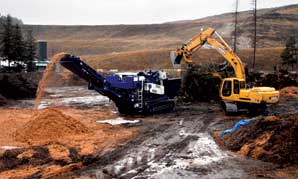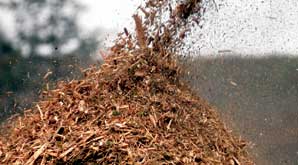As the popularity of biomass energy grows throughout the forest-rich areas of the Northwest United States, Montana has cemented its position as the standard-bearer for a large six-state effort called the Fuels for School and Beyond Program. The Big Sky state has nine of the 14 biomass boilers currently operating under the program, including ones in Glacier and Eureka high schools.
Biomass boilers are considered eco-friendly as they encourage the use of wood that would otherwise be burned or dumped off at the landfill, including the large amounts of branches and brush leftover after an area is logged, as well as bark and the remnants of demolished houses. Also, biomass boilers are said to save a lot of money, though they require more attention to operate than their natural gas cousins.
 |
|
Brush is loaded into a horizontal grinder at Flathead Wood Recycling off U.S. Highway 93. The local company produces fuel for the Glacier High School and Eureka school’s boilers. |
Chuck Cassidy, transportation and facilities director for Kalispell public schools, said a January report showed that last year it cost $87,000 to heat Glacier, while the district spent $206,000 at Flathead High. Glacier’s heating bill is a combination of biomass and natural gas, while Flathead’s is strictly natural gas.
“It’s unbelievable,” Cassidy said of the money saved.
Flathead Wood Recycling, a subsidiary of T.B. Gray Inc., provides Glacier and Eureka high schools with its “hog fuel.” Using a $325,000 grinder, workers at the wood-recycling yard located near the county landfill, grind up wood into large piles that are then transported to the schools to be burned in the biomass boilers. Low quality wood, as well as grass and leaves, is ground up for mulch. The mulch is used as topsoil in landscaping because it’s aesthetically pleasing and it helps the soil retain moisture for plant growth.
Travis Gray, owner of T.B. Gray, is encouraged by the state’s shift toward wood recycling, but he feels it’s only the tip of the iceberg in terms of the potential of recycled wood. He mentioned the use of waste wood in cogeneration plants to produce electricity in other states.
“We’re about 12 years behind the time,” Gray said.
Both Gray and the Kalispell school district have discovered a tricky learning curve in implementing the new biomass technology. The school district just wrapped up a project in October that worked out several bugs in the biomass boiler at Glacier. School officials were initially under the impression that the boiler was equipped to burn a wide range of wood products, from pellets to chips to hog fuel, Cassidy said. But they found out it didn’t do so well with hog fuel, which is what’s available locally.
So last month components of the boiler were altered and retrofitted to become more compatible with hog fuel. Cassidy said the improvements have been dramatic. The biomass boiler is now running consistently and efficiently five days a week. On the weekends, four smaller natural gas boilers take over for a variety of reasons, Cassidy said, including cleaning and the fact that the biomass boiler needs to be monitored.
 |
|
Flecks of green needles are seen among ground brush at Flathead Wood Recycling. Different combinations of moisture and wood content are used in different applications from grounds keeping to school boilers. |
“It looks very successful so far,” Cassidy said. “The whole building doesn’t need heat on weekends (now), but when it gets really cold we’ll want to use biomass all of the time.”
Montana is one of six states involved in the Fuels for Schools and Beyond Program, which promotes and facilitates the use of forest biomass waste for energy in public buildings, especially schools. In Montana, the program is a partnership between the Department of Natural Resources and Conservation, the U.S. Forest Service, private forestry companies and Bitter Root Resource Conservation and Development.
Angela Farr, Montana’s Fuels for Schools director, said an elementary school in Deer Lodge is currently shifting to a biomass boiler, which will make it the 10th school district in the state. Also, Farr said her organization is in discussions with the state prison and a handful of hospitals.
At Flathead Wood Recycling, Gray doesn’t charge for people to bring in non-commercial loads of wood and other plant material, but commercial outfits pay a fee of $25 per ton. Gray encourages people to deliver as clean of wood as possible, meaning without nails, rebar and rocks, among other substances. He and his employees try to clean out the rest of non-desirables, with the help of a magnetic pulley on the grinder that removes much of the metal. Not only do those foreign substances harm the grinder, they also make the processed wood less efficient when being burned.
The cleanest woodpiles are reserved for the school biomass boilers. Gray also tries to attain a consistent moisture level to aid in efficient burning. The lesser quality fuel is sold to Plum Creek to be burned at its mills in the valley. Then the lowest grade fuel is sold to Missoula’s Smurfit-Stone cardboard plant, which is the biggest user of biomass energy in the state, Farr said. It produces much of its own biomass fuel as well.
Depending on the size and type of material being fed into the grinder, Gray said he and his employees can make 10 tons of fuel per hour. Ideally, Gray supplies Glacier with 50 or 60 truckloads of fuel per week, with each load containing between 15 and 20 tons.
Cassidy said Gray, who is in the second year of his contract with Kalispell schools, has enabled the district to work through the initial bumpy period with the school’s biomass boiler.
“He’s been a great provider – Johnny on the spot,” Cassidy said.